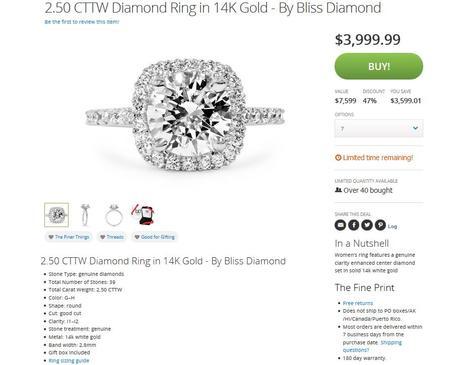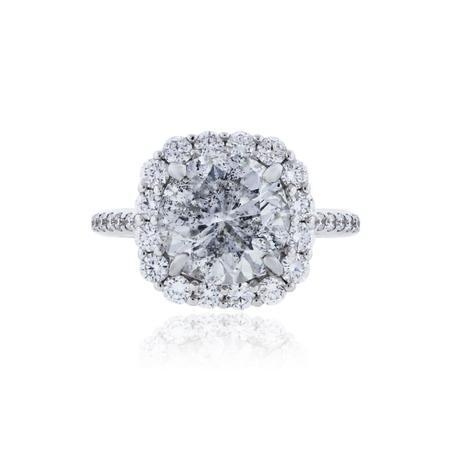That’s not a joke. Despite your feelings on getting a Groupon engagement ring, the site can be used to score great deals. But that’s all relative, as vendor “Bliss Diamond” demonstrates. Why? Here’s why:

It’s obviously not. I can’t even tell you where that retail price came from, because there is so much wrong with this listing. First of all, 2.5 carats is the total weight of the ring. There is NO mention of the carat weight of the center stone! The mounting could be anywhere from .25 carats to 1.00 carats of smaller diamonds, so the lack of info on the center stone is shady. And even if the center stone’s carat weight was listed like it should be, I’d still be guessing at a fair retail price because comparing this diamond to one in Raymond Lee’s inventory is impossible. But basically a diamond with this treatment (and still such a bad clarity grade) would be worth $500 a carat – if you could even find someone to buy it. This diamond is clarity enhanced.
The way this is disclosed, with the “stone treatment: genuine” is misleading. By law, the fine print had to include the “clarity enhanced” stipulation, but toss genuine in there and it’s enough to confuse the average customer. When you’re shopping for a diamond, you’d likely want to see diamonds with no treatments. Clarity enhancement is a great way to save money (as you can tell) but this ring is still a ripoff. It’s just not worth $4000, let alone the inflated suggested retail price.
Clarity enhancement can mean any of several treatments a diamond might get to bump up its clarity grade (which also makes me wonder what on earth this rock looked like before the clarity enhancement to get it to a barely jewelry-quality grade of I2.) The certificate would still have the enhanced grade on there, not the original. Common treatments include laser drilling or fracture filling. To fill fractures, a tiny amount of glass material is introduced into super-thin crevices and fractures (aka feathers). Laser drilling is meant to zap away inclusions. It doesn’t affect the other characteristics of a diamond, like its carat weight or color. GIA has concluded that for normal wear, clarity enhanced diamonds are durable, but may be more susceptible to high heat, pressure or corrosive materials.
Which brings me to my next point. What lab decided this diamond’s clarity and color grades? There’s no mention of cut, and because GIA won’t grade clarity enhanced diamonds, who knows which lab decided this diamond’s report card. And as you know, the lab that certified your diamond helps determine its value.
Clarity enhanced diamonds are, to begin with, stones of lesser quality than RLJ would typically buy and sell. Most likely, a clarity enhanced stone is somewhere around and I1 or I2. Enhancing it will likely only get it up to an SI clarity grade, but the man-made treatments & enhancements devalue the diamond greatly and can even compromise the diamond’s structure.
Finally, the ring pictured in the listing does NOT look like an I1 or I2 clarity grade. This is what an SI3 clarity grade looks like:

This is one clarity grade better than I1 – and if GIA had graded it probably would be an I1.
So, if you’re wondering what the catch is with this Groupon deal, it’s that those prices are both insane. Insanely high for what you’re actually getting. And if you already bought this deal, I would humbly recommend you take advantage of the free return option and use your $4,000 to buy one of these instead.

